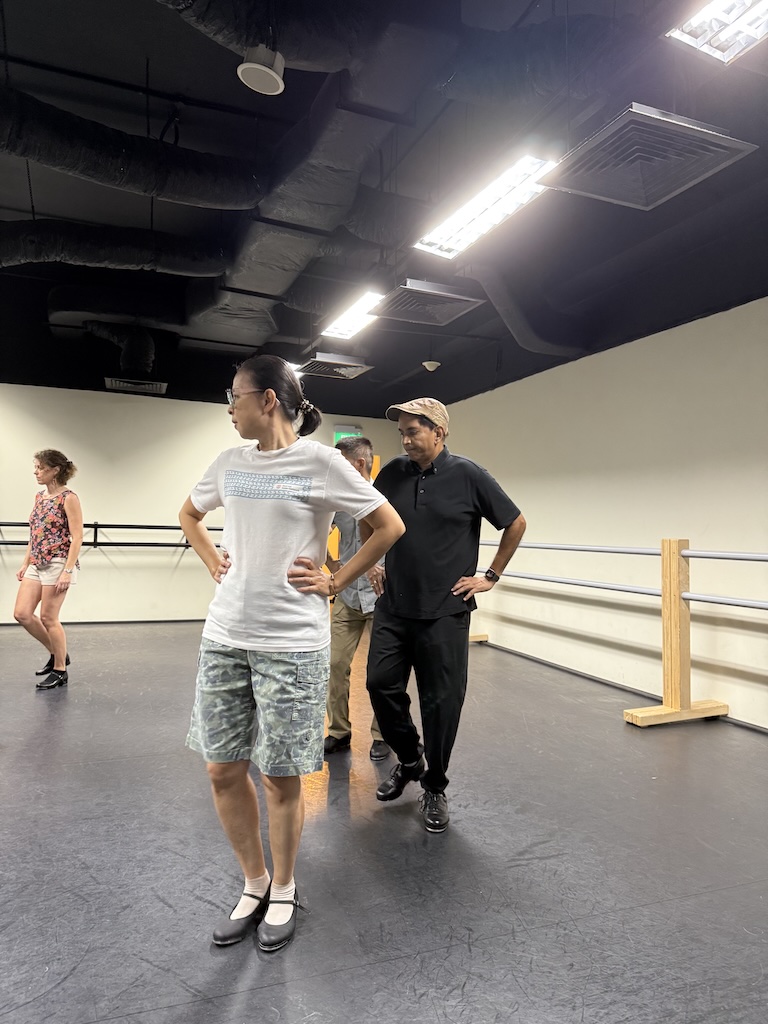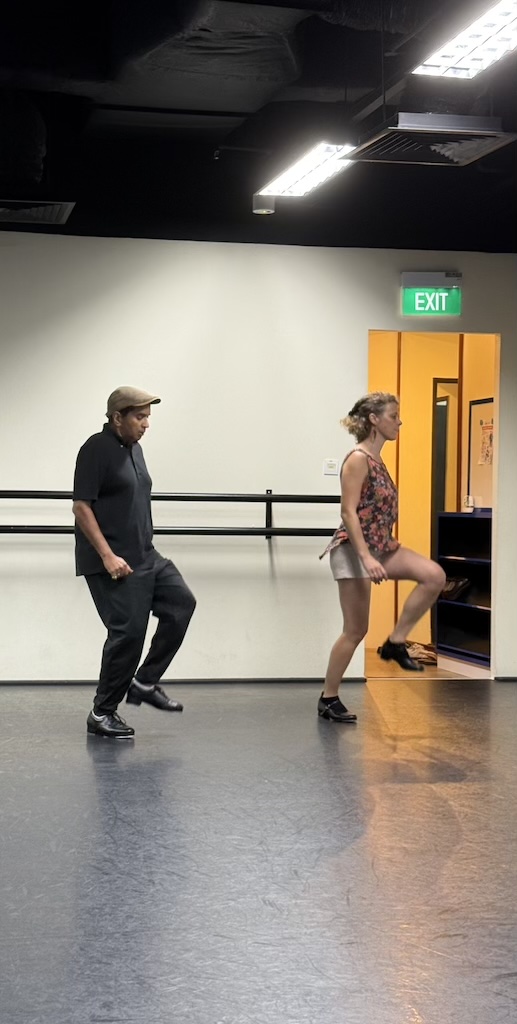Living with no regrets
Calvin Murty is keeping his life active including tap dance and checking off his list of interests.

Calvin Murty got interested in tap dance during his teenage years.
During his teenage years, Calvin Murty became interested in tap dance, having watched movies like musical fantasy film Xanadu starring Olivia Newton-John and older movies with legendary dancers like Gene Kelly and Fred Astaire. The 62-year-old, who is single, shared: “The movements looked challenging, fun and elegant, and I always wondered if I would be able to do something like that someday.”
That “someday” came after his 60th birthday and more than two years after retiring as an associate registrar at the National University of Singapore, a job he held for 32 years. He became aware of a dance school called Dance Arts, a member of Dancepointe Academy, that had tap dance classes for beginners. “Since I had just begun my senior years of life, I thought it would be a good form of exercise and active ageing, since it was something I always had an interest in, and since I never took up formal dance classes before.”
By that time, Calvin had already checked off many of his interests that he had wanted to achieve such as taking courses including how to use Ableton, a software for music creation and performance, and another on writing one’s autobiography. He even got to learn more about singing and recorded a Christmas album with a producer, and picked up pickleball lessons with a coach. Tap dance was now within his reach.
The first time
He remembered vividly the first time trying tap dance. He shared that the school offered a trial class so you could try and see if you wanted to continue, and tap shoes were provided.
“During the class, most of the movements and steps were quite manageable if done at a slower pace (e.g. like immediately after the teacher had demoed it). But once a step was taught, it was repeated at an ever-increasing pace and so it got increasingly more difficult to execute them perfectly during that first lesson. And once a few steps were learnt and put into a sequence, it was quite a challenge to remember which step came after which! Nevertheless, the spirit in the class was one of fun and hence it was not stressful when mistakes were made.”
Calvin shared that it helped that the teacher was patient and mindful of the different age levels of the students, and would often repeat the demos if she found some students having difficulty in getting the steps correct.
He added: “At the end of that class, I felt it was something I could handle and I took the plunge by buying a package of 12 lessons and later that week, went to a dance store to buy my own pair of tap shoes.” With that settled, he continued to persevere.
“As time progressed, some of the steps demonstrated by the teacher could be quite complicated, especially for someone who has never danced before. It can also be discouraging when younger students pick up the steps so quickly whereas people like me might take longer to get it correct. Nevertheless, as long as one is realistic about one’s limitations, and not compare themselves to those who are younger or who may have had dance experience, I came to believe that there is no need to be discouraged.”
He is also the oldest in the class and one of few men, with women making up the most in the class. “All this doesn’t affect me one bit! I am never bothered about such things. I’m there to learn and have fun while I am still able to. Granted, given age, lack of formal dance experience and the limitations these may bring (e.g. it gets more difficult to do complicated steps at faster speeds as the class progresses to different/higher levels), until such time I find it too difficult to keep up, I intend to go as far as I can. Tap dance is in any case a dance form meant for both genders anyway, and in the class I attend there are usually three guys – provided all of them turn up!”
Committed and not wanting to fall behind, Calvin makes it a point to put in extra effort. During the week, he practises the steps at home, either recalling from memory or using demos from YouTube to refresh his memory so that he can improve and be ready by the time the next class starts. His class is now every Saturday afternoons for one hour.
Coming to two years

Calvin perseveres and continues to have fun.
Today, it is coming to two years, since the faithful day he took up tap dance. There are many reasons why he continues to do it. “What I like about tap dance is apart from the dance form itself which I always liked to watch, I believe it has physical and social benefits. I think I have improved in my mind-body coordination, as longer choreographed sequences require one to recall which steps come after the next, and which steps go with which section of the music being used for the dance. This is a good workout for the brain and memory power, as in a choreographed dance, everything happens at a rapid pace.”
He added: “I also have learnt more about the art of tap dance itself, including some of the technical terms and the correct way to execute certain steps, etc. Tap dance is also something that one can practise solo – i.e. unlike some forms of dance like ballroom dancing, no partner is required, and one can practise anywhere and anytime.
“In addition, once a tap dance move is more or less perfected and performed well, there is a sense of achievement and accomplishment. Tap dance can also be quite vigorous at times, and as such it can also be used to improve physical fitness. Finally, it also provides opportunities for social interaction as the class would normally have people from all walks of life and of different ages.”
Calvin shared what happens usually in his class (there are different classes available to cater to different skill levels). It starts with basic steps being reviewed while using the barre for support. The basic steps will slowly increase in speed and complexity. After that, the teacher will bring the class to the centre of the room and teach a set of sequences of steps which may require the dancers to move from one end of the room to another. More and more sets are added until it almost becomes a dance routine set to a particular piece of music.
Recital
He also shared that the class is preparing for the year-end recital so in the last 20 to 30 minutes of the class, it is spent reviewing the steps and going through the routine in preparation for the performance. He knows exactly what happens in a recital as he participated in the previous one.
During the last recital, the tap dance groups which consisted of beginners, intermediate, advanced, etc, presented a combined dance item at the University Cultural Centre. He recalled the theme was on movies, and the dancers danced to songs from the movie Mozambique, so it had a safari theme.
“Apart from learning the steps, we had to put together our own costumes with guidance from the teacher and that was fun for me as I enjoy doing creative things like making my costume more interesting. We did not have make-up artists so I had to learn from my sister/aunt how to apply my own make-up and eyeliner!
“There was a full dress rehearsal prior to the actual concert and in between, a long time of waiting during which we had meals catered for us. It was during this time we got to know members of our own class better as well as people from other classes – this social aspect was quite enjoyable and interesting as well.”

He wants to go as far as he can with tap dance.
He added: “While parts of the dance were challenging, I managed to more or less learn and execute all of them with reasonably good ability, and the item was a hit with the audience. Most of the people I spoke to after the show said our item was the best and most interesting/enjoyable. My family and close friends also came to watch it and said they enjoyed the performance, so it was a really meaningful time for me as well, to have their love and support.”
Just do it
Calvin dished out some advice to other seniors as well as his learnings from his active life: “I would encourage them to look back to their past to see if there was anything in their life they always wanted to do, and just go ahead and do it, provided there are no health, medical or other conditions prohibiting them from doing so. With patience and determination, they might achieve results they never expected and may be pleasantly surprised at their ability to pick up a new skill too.
“It would be good to have a realistic mindset – someone at age 70 will never be as agile or flexible as someone in their 20s, so don’t compare yourself to others – let yourself be the one you challenge! It would also be good if the new activities picked up are more active in nature, i.e. things that involve some form of exercise or movement, and something that engages the mind and use of memory.”
Finally, he said: “Don’t be concerned about others who may say things like it is not right for ‘someone your age to be doing this’! Go and fulfil your dreams so that at the end of the day, you’ll have no regrets!”
——————————————————
SIDEBOX: More seniors interested in tap dance
Ageless Online talks to Dancepointe Academy’s dance teacher, Susan Thng, about this growing trend:

Susan Thng.
Why is tap dance suitable for seniors?
Because tap dancing doesn’t require flexibility of their body and it’s easy to pick up. It mainly involves creating rhythms with their tap shoes.
What are some benefits you get from tap dance?
Balance, posture, improvement in memory and muscle memory, and one becomes more rhythmic.
Dancepointe Academy is the first to offer tap dance classes that are tailored to seniors at its City Square Mall outlet. Why target seniors?
I have been teaching adults for the past 36 years. In the past, I would get two adults aged past 50 and the rest were 20s to 40s. But now, I have 15 students who are above 50. My seniors have been learning together with the younger adults all this while.
However, seeing that more seniors are keen on tap dance, I plan to form classes solely for 50s and above. I realise that seniors of this era are no longer happy just staying home. They want to keep themselves active by participating in interesting activities and socialising with peers. Tap dance is definitely one activity they should consider.
Can you share how different these classes for seniors are from classes that are tailored to those younger?
I will always start with simple warmup exercises on the barre to loosen their ankles. Then we will move on to centre floor exercises and finally a short dance. Everyone learns the same exercises and choreography together. However, seniors struggle with memory and speed thus need more time to get the steps into their brains. So I will stop adding more steps once I see them struggling but will add on for the younger ones. Basically they just need more time to absorb and practise. The other thing they struggle is speed so everyone will practise the dance with slower music and progressively move on to a faster one for those who can. Otherwise, I just stick to slow music.
How many of these classes do you hold each week and for how many hours?
Currently, I have 10 classes in a week with each class being an hour long.
Can you break down further – how many over 60s do you teach each week?
Currently, I have three students who are in their 60s, and they are from different classes.
Can you share two memorable students who are 60 and above?
One of them is my student’s mother who used to bring her kid to my class every Saturday. After a few years, she decided to give tap dance a try and has since been dancing with me for more than 10 years. She is currently at an advanced level and has been performing in numerous recitals. She and I have become close friends too!
The other one is a retired man who started tap dancing at 60. Initially, he was very shy and conscious, especially when he couldn’t remember the steps. So I told him to video the dance so he could go through it before the next class and it helped. He performed in last year’s recital and will be performing at the end of this year again! He has become more confident and sociable too.

0 Comments